Saved dendrobium orchid removed rotten roots, now its growing new ones plantclinic
Signs of Orchid Root Rot . Any time stems, leaves, or aerial roots start to look limp or pale, the best place to start is to remove the orchid from its pot and examine the roots. Rotten roots are discolored, brown or black, soft, mushy, and flat (lost turgidity.) Healthy roots should be swollen and firm, and green or silvery gray-green with a.

Is it root/stem rot? orchids
Rotted roots are brown, mushy, and may even have black spots. You can tell if the roots are rotting by feeling them. Orchids with stem rot can be safely treated with 3% hydrogen peroxide. Snip the brown, mushy parts of the stems below the new roots. You should also remove all dried leaves. Using hydrogen peroxide is an effective way to.
:max_bytes(150000):strip_icc()/sp-how-deal-with-orchid-root-rot-7090606-step-04-799b83c4dcee4ff3b56992ab07377a53.jpg)
How to Deal With Orchid Root Rot
The number one way to prevent root rot in your orchids is to water the orchid when the potting media is nearly dry. If your orchid is planted in a clear plastic orchid pot, this makes it easier to keep an eye on the orchid roots. Water only when the potting media is nearly dry and the orchid roots are silvery gray.

Is My Orchid Dead? What are the Signs? Plantly
Orchid Root Rot vs. Healthy Roots. Looking at an orchid's roots for the first time, you may be unsure of what a healthy plant should look like. An orchid's roots are a few millimeters thick, larger in diameter than the average house plant. The roots appear similar to miniature tree roots, winding and weaving their way through the airy.
This orchid I post months back about recovering from having root rot and all the roots destroyed
Overwatered orchid root rot: One of the most common causes of is overwatering. Orchids are epiphytic plants, meaning they naturally grow on trees and absorb moisture from the air. To identify overwatering as the cause of root rot, check the color and texture of the roots. Healthy orchid roots are usually white or light green and firm to the touch.
Desert Orchid Taking Care Of Root Rot in a Cymbidium Orchid
Overwatering is the number one cause of root rot. An orchid's roots can only take in just so much water before they start to weaken and break down, creating an environment for bacteria and fungus to creep in. It is fungus that causes root rot, and water is fungi's best friend. Most indoor orchids need only to be watered once per week at the.

How to Fix Root Rot in Orchid Plants
Keep blotting and soaking up moisture until you feel you've got the roots as dry as you can; this gives your plant the best chance of success in getting over the root rot. Now, you need to let the air do the rest for a while. Take a sheet of clean newspaper and spread it out, and then transfer the orchid to this.
Does this look like root rot? I keep this dendrobium in orchid bark with lots of drainage and
Orchid root rot . Brown orchid roots are dying, and black roots are dead. Only green roots are healthy. When they're not, orchid leaves wilt, blooming reduces, and eventually, the plant dies. To treat it, damaged roots need to be trimmed off. To prevent it from reoccurring, repotting needs to happen every year to two years.
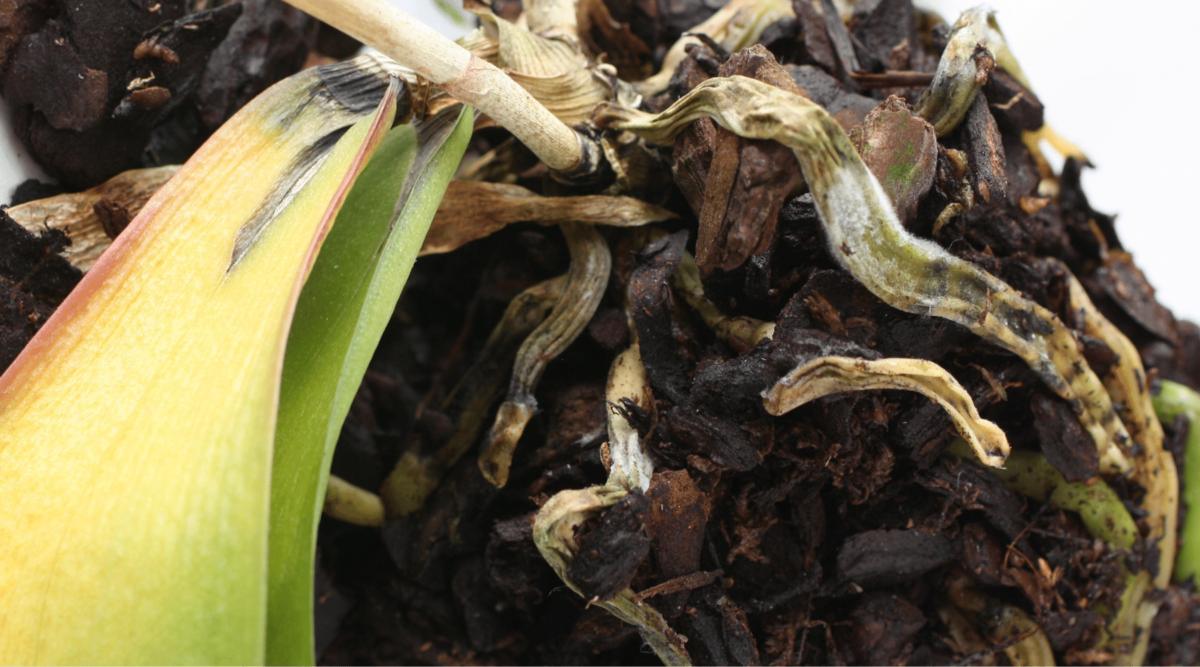
How to Fix Orchid Root Rot (Symptoms, Care, & More) Orchid Bliss
Root rot is a broad classification that references diseases affecting plants root system, causing them to decay and break down.. Both plants with green and fibrous stems can develop this disease. Overwatering is one of the leading causes of root rot in orchids because the soil can become easily waterlogged.; When this happens, the root system slowly loses its capacity to get adequate amounts.

Cattleya Orchid Root Rot Orchid Flowers
Rot on orchids typically happens when water is trapped at their base in a non-draining pot and/or they are overwatered. Most orchids come in two pots with the inner pot having drainage and the outer pot not having drainage. This can affect both the crown and the roots causing rot. Please stop and click here before you proceed if this is the.

How To Tell If Roots Are Dead ROOTHJI
Trimming Rotted Orchid Roots. If any of your orchid's roots are rotten, it's necessary to get rid of them as soon as possible. Look for brown, black, squishy, or spotted roots. All rotten roots will need to be removed for your plant to survive. This could be almost all of your plant's roots, depending on the severity of the infection.

Maria's Orchids Roots rot on psychopsis mendenhall
Remove the plant from a pot and carefully separate the soil from the roots. To restore an orchid with rotting roots, it is necessary to remove the plant from the soil. After all, it contains a bacterial infection. Work better with help of the long and thin tool. Even a stick for Japanese cuisine will do.
Just got this D. nobile. Is this root rot? r/orchids
Overwatering. This is the usual cause of orchid root rot. It can be caused by watering plants too frequently or allowing your plant to stand in water for more than 20 minutes. Overwatering can also be caused by the breakdown of the potting mix leading to it holding on to water, and reducing air around the roots.

Treating possible stem rot on Phalaenopsis Orchid YouTube
To treat orchid root rot, you will need to take the plant out of its pot and check its roots. Pull the orchid very gently from out of its pot. Brush off any growing medium that is still clinging or stuck in between the roots. You will then need to gently rinse and clean the roots of your orchid in lukewarm water.
Is this root rot?? orchids
Un-pot the orchid and take a look. Look for these Signs of root rot. Healthy orchid roots are light green or silvery in color. Over watered and Rotting roots are dark green or black. Squeeze the roots. They should be firm. Rotted roots are mushy. Healthy roots are thick, firm and light in color.

Having meltdown Orchid Roots Rotting. PLEASE HELP ME! orchids
8. When replanting, do not force the roots to enter the pot, as it is unnecessary: the orchid can survive without problems with its aerial roots. Add some sphagnum to the surface of the substrate. 9. Lightly mist the plant with a little leaf revitalizer, focusing on the underside of the leaves. 10.